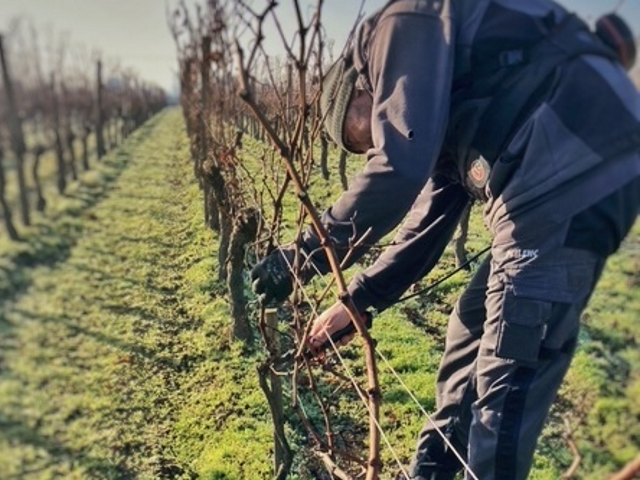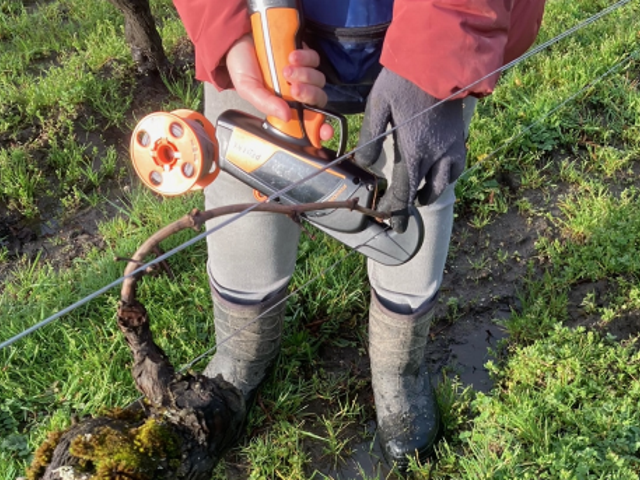
Like most agricultural products, vines can be attacked by various parasites that can compromise the harvest or, in the worst case, lead to the death of a vine. Thus, in order to obtain a quantity of grapes that is economically viable for the winegrower and an optimal sanitary and organoleptic quality that is essential for the production of great wine, 100% of winegrowing operations use phytosanitary products (pesticides). At Château Plince, the protection of the vineyard is based on the main principles of sustainable agriculture:
Our environment and our health are precious, let's preserve them.

The pruning of the vine starts during the month of November, when the vine has lost almost all its leaves. This is by far the longest operation carried out by the winegrower as it takes place over a period of two to three months. At Château PLINCE, we practice the so-called Guyot simple pruning. This method consists of leaving on one side of the foot a long branch called the aste and on the other side a very short branch (less than ten centimetres) called the côt. It is on the cane that the bunches of grapes will develop when the weather returns, while the side branch will provide the cane for the following year.
Les carassones sont le nom donné aux piquets de vigne destinés à supporter les fils inox constituant le palissage. Jusqu’à une époque récente l’ensemble du vignoble était exclusivement équipé de piquets d’acacia. Au fil des saisons, les passages réguliers des engins agricoles ainsi que l’environnement naturel (humidité, termites, gel) endommagent certaines carassones qu’il convient alors de remplacer. On profite de cette opération dite de carassonage pour retendre, réparer ou remplacer si nécessaire les fils inox ainsi que leur système d’ancrage dans le sol appelé culée. Depuis 2020, nous avons fait le choix d’utiliser des piquets métalliques qui offrent de multiples avantages : Carassones are the name given to the vine stakes designed to support the stainless steel wires that make up the trellising. Until recently, the entire vineyard was exclusively equipped with acacia stakes. As the seasons go by, the regular use of agricultural machinery as well as the natural environment (humidity, termites, frost) damage some of the carassones, which must then be replaced. This operation, called carassonage, is used to tighten, repair or replace, if necessary, the stainless steel wires and their anchoring system in the ground called abutment. Since 2020, we have chosen to use metal stakes which offer multiple advantages:
With the exception of December and January, the soils are the subject of constant attention, mainly consisting of eliminating the grass that competes with the vines and therefore hinders their good development. In the recent past, this operation was largely based on the use of herbicidal products, known as chemical weeding. These products, although effective, were not without consequences on micro-organisms and soil life. For these reasons, we prefer mechanical weeding which, in addition to its ecological qualities, allows aeration of the soil which favours water penetration. Moreover, by cutting the superficial roots of the vine, it forces the vine stock to take deep roots.
In the spring, the disbudding operation consists of removing a few buds from the branch (the aste). This is an exclusively manual operation which reduces the load on the vine stock and thus encourages the development of bunches of much better quality. Studies have shown that de-budding also allows an increase in the potential degree of alcohol.
De-budding is a concomitant operation to disbudding which also aims to relieve the pressure on the vine stock. It consists of removing the shoots of branches called "pampres" which develop at the base of the vine. Once again, we have now decided to abandon the chemical removal of shoots from the base of the vine stock as it was done before, in favour of a mechanical removal of shoots that is more environmentally friendly.
Lifting and tilting the vine are operations that consist of verticalizing the shoots that grow in all directions and trapping them between the two mobile stainless steel wires of the trellising, which are called leveuses. These wires, held by biodegradable staples, are lifted and then raised as the vegetation grows by hanging them from the stakes. This operation is greatly facilitated by the use of the new metal stakes.
The trimming is a mechanical operation of equalizing the upper part and the side parts of the vine row to contain the expanding foliage. It allows on the one hand to reduce the wind-up of the rows of vines in the event of a storm and on the other hand to eliminate the new leaves more vulnerable to diseases since they have not benefited from the treatments that may have been carried out. before. Finally, it should be noted that trimming also gives the vines this characteristic aspect of our Bordeaux wine-growing landscapes.
Au fur et à mesure que les grappes se développent et prennent de l’ampleur, il sera nécessaire de veiller à ce que chacune d’entre elles puisse s’épanouir dans les meilleures conditions, que ce soit d’un point de vue ensoleillement mais aussi d’espace. On procède donc à deux opérations qui sont l’effeuillage et les vendanges vertes. L’effeuillage consiste à retirer une partie du feuillage qui entoure la grappe afin qu’elle bénéficie d’une luminosité optimale tout en veillant à tenir compte de l’exposition : ainsi on favorisera l’effeuillage des parties Nord et Est afin de préserver les raisins des rayons du soleil aux heures les plus chaudes de la journée. A l’approche des vendanges, on procédera également à une opération dite de vendanges vertes qui consiste à couper quelques grappes sur chaque pied afin d’abaisser le rendement au profit de la qualité. Cette étape est aussi l’occasion de réajuster les grappes restantes dans une position tombante idéale à la bonne maturation des baies. As the bunches develop and grow, it will be necessary to ensure that each of them can blossom in the best possible conditions, both in terms of sunshine and space. Two operations are therefore carried out: leaf thinning and green harvesting. Leaf-thinning consists in removing part of the foliage that surrounds the bunch of grapes so that it benefits from optimal luminosity while taking into account the exposure: thus we favour the leaf thinning of the northern and eastern parts in order to protect the grapes from the sun's rays at the hottest times of the day. As the harvest approaches, we will also carry out an operation known as green harvesting, which consists of cutting a few bunches of grapes from each vine in order to lower the yield and improve quality. This stage is also an opportunity to readjust the remaining bunches to an ideal falling position when the berries are ripe.
Racottage or complantation is a fundamental operation that consists of replacing each year the few vines that have not survived diseases or that may have been pulled up accidentally with new plants. This operation is carried out either in the autumn or in the spring.
From the end of the harvest or in the spring, it is important to take care of the land from which the vines draw the elements necessary for their good development. To do this, two types of fertiliser are applied to the vines:

In viticulture, the term petites façons refers to a set of manual agricultural tasks that are often complementary to the operations we have just presented and among which we find :